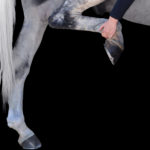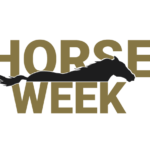October 18, 2009 — A stormy weekend at the Dansko Fair Hill International cleared today, and the international competition picture for American eventing brightened as well. I saw several good prospects for the home team at the 2010 Alltech FEI World Equestrian Games.

Former Australian Boyd Martin won his first CCI as a U.S. citizen, and the Star-Spangled Banner was music to his ears as they played it for him and his feisty mount, Neville Bardos, during the awards ceremony. We’re lucky to have Boyd on our side now.
The CCI is the most arduous format at the upper levels of the sport, and it was even more so here at the Fair Hill Natural Resources Area yesterday, when cross-country was run in mud, mud and more mud after several very damp days.
Boyd and his ex-racehorse were the only ones to make the 9-minute optimum time in the rain. There were dozens of dropouts in both the 2-star and the 3-star rated sections before cross-country even began, and understandably so.
Olympic veteran John Williams was second after dressage in the 3-star with Sweepea Dean, but he felt it wasn’t right to take a relatively green horse around the rugged route in a downpour and have him get discouraged.
Explaining why he decided not to ride yesterday, John said, “Hearing it start to rain again at 4:15 in the morning and then it rained steadily, and seeing the footing get progressively worse, I thought, `Why would anybody want to run in these conditions?'”
I put it another way for myself, “Why would anyone want to go out and take photos in this kind of weather?” I didn’t have an answer to that, but I went out and slogged around anyway, looking as if I’d been mud wrestling when I was finished. It was okay; everyone else who ventured out looked the same, so I was in good company.
Still, the ground wasn’t as bad as it could have been elsewhere, where the grass isn’t rooted as deeply. As Fair Hill co-chair Trish Gilbert noted, “We’re very fortunate being able to have this piece of property with this old turf. It makes a huge difference.”
Organizers and officials put their heads together as they delayed the cross-country start time and worked on figuring out what to do, eliminating fences and shorting the courses designed by Derek DiGrazia. I spoke with technical delegate Jonathan Clissold about what they faced in the process.
There is no other fall 3-star in the U.S., which meant it was important for many of the riders at that level to finish so they could qualify for Rolex Kentucky in the spring and perhaps have a shot at the World Equestrian Games. Others, however, felt they didn’t want to ride a course that wasn’t “the full experience,” as Bonnie Mosser put it.
Bruce Davidson, that veteran of veterans, told me why he withdrew his horses and how he felt about the changes.

On the other side of the coin, many felt that the conditions raised the level of the revised course to make it a true 3-star. There were several good ones who didn’t get around. Nicki Henley, third after dressage with Mara Dean, ran out at a narrow brush that was the second part of the Chesapeake Water, so she called it a day. Tiana Coudray of California quit near the end of the course with Ringwood Magister after having two refusals. But 32 of the 35 who finished had no jumping penalties, though as I noted before, only Boyd was time-fault-free, so that tells you something about the nature of the test.
Boyd rose from 16th to be the overnight leader with 51 penalties going into today’s stadium jumping over a demanding course designed by Sally Ike, the U.S. Equestrian Federation’s manger of show jumping. The dressage winner, Karen O’Connor with Mandiba was tied with Boyd’s mentor, another former Aussie, Phillip Dutton, on 55.2 penalties. Boyd had a rail in hand, but he says he doesn’t think about those things, since he’s only interested in the big picture rather than statistics.

Phillip, who is still getting to know his rather difficult French-bred mount, dropped two rails, which put him fourth. Karen, concentrating on making a left turn at fence number 8, a blue-and-white striped vertical, instead of a right turn as she had in the 2-star during the morning with Allstar, started turning Mandiba before he left the ground, and dropped a rail.
Boyd looked golden until the third-to-last fence, an oxer that was the middle element of the triple combination, where Neville Bardos dropped the front rail. Unflustered, Boyd continued, crossing the finish line and then galloping on with a thumbs-up as he was announced the winner. That rail-in-hand came in handy.
Kelly Sult, third with Hollywood on 60 penalties, moved up from a tie for 33d after dressage. Hollywood, who is 17 and getting better with age, was one of 12 horses who put in double-clear show jumping rounds. Kelly named him after seeing a movie that featured a horse named Hollywood who could talk, though her guy hasn’t done it yet. A 23-year-old Pennsylvanian, Kelly won a whole raft of awards, including best adult amateur rider and best rider under 25.
Others who had promising finishes and could be WEG material included Sinead Halpin, fifth with Manoir de Carneville; Boyd’s other mount, Remington XXV and Sharon White (her followers are called the Tangerines because of her affinity for orange), who was seventh with Rafferty’s Rules. All three were double-clear in show jumping.
Boyd, who was late for the post-competition press conference because he ducked into the VIP tent to get a beer, has an interesting way of putting things.
The Pennsylvanian called his mount “a real tough mongrel of a horse. If you look at all the top horses here, they’re not show ponies. If they were people, you’d see them in a bar fight. The fancy shiny ones who have European mothers and fathers and sisters and cousins are dead meat in tough conditions.”
I asked Karen how Mandiba would feel about that comment.
“I think he’s a tough prep school kid,” she said, noting he’s had a privileged life.
“He’s pretty and shiny but he definitely has some grunt. I think Boyd’s dead right, if you have conditions that are adverse, you’re going to learn a lot about your horse.”

Hannah Sue Burnett, winner of the 2-star on St. Barths, learned a lot about herself as well as her horse. She works for the O’Connors at their farm in Virginia and is coached by Karen’s husband, David, who told her not to be discouraged when she finished tied for 15th in dressage. Hannah listened and went on to log one of only two double-clears on cross-country in the division and rose to the top of the heap with 51.9 penalties. Canada’s Rebecca Howard (also coached by David, who is her country’s technical advisor) stood second with Roquefort on 53.8, while Doug Payne, son of Olympic eventing judge Marilyn Payne from New Jersey, was third with 55.1 on Running Order, an Irish-bred to whom Saturday’s conditions didn’t matter.
Doug had a rail when his relatively green mount was distracted by all the photographers by the ring, but Rebecca toppled two rails, dropping her to third and elevating Doug to second.
Then it was up to Hannah, who had a picture-perfect trip until the last fence, when it suddenly got ugly. She muffed her distance and the chestnut crashed through the green rail and planks. Hannah kept her head and her seat, focusing on getting through the finish line to end up 3.2 penalties ahead of Doug and thankful for that handy rail-in-hand.
Was she embarrassed by what happened? Of course. “I don’t want to talk about it,” she grimaced good-naturedly as she headed out of the ring.
“That was awful,” she said, to which someone rightly retorted “That was fabulous.” (You’ve got to look at the big picture.)
The horse is owned by Dick Thompson, a longtime supporter of Karen’s, who wants to give younger riders a chance. He wound up presenting the Sea Horse Trophy, named after his farm, to himself, since it goes to the top horse in the 2-star. He and Hannah looked at it as a nice memorial to his late wife, Vita, with whom he owned all-time great eventing horse Biko.
I caught up with Hannah and asked her to sum up her experience this afternoon.
That’s it from here, but look at my Fair Hill photo gallery. Now I need to brush the mud off everything I own and get ready to head to the Washington International Horse Show. Thank goodness it’s indoors! I’ll be sending you a postcard from there next Sunday.
Until then,






